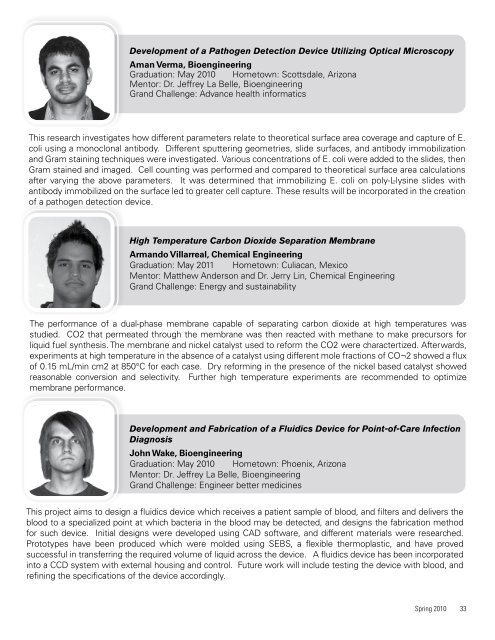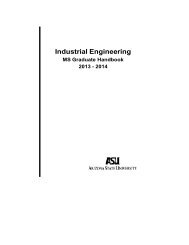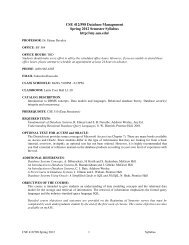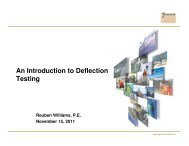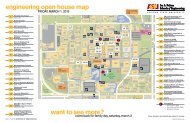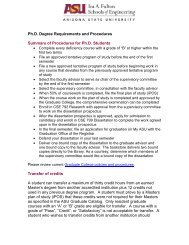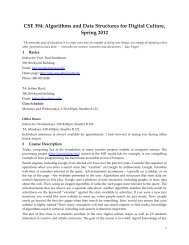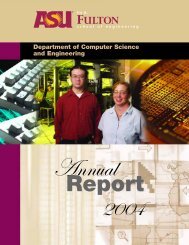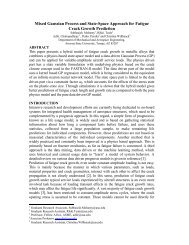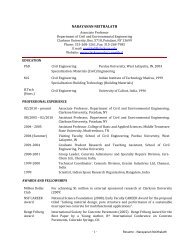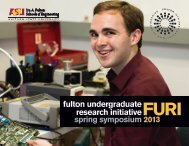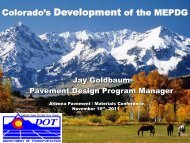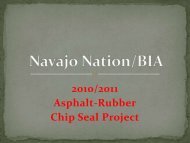Abstract Book - Ira A. Fulton Schools of Engineering - Arizona State ...
Abstract Book - Ira A. Fulton Schools of Engineering - Arizona State ...
Abstract Book - Ira A. Fulton Schools of Engineering - Arizona State ...
Create successful ePaper yourself
Turn your PDF publications into a flip-book with our unique Google optimized e-Paper software.
Development <strong>of</strong> a Pathogen Detection Device Utilizing Optical Microscopy<br />
Aman Verma, Bioengineering<br />
Graduation: May 2010 Hometown: Scottsdale, <strong>Arizona</strong><br />
Mentor: Dr. Jeffrey La Belle, Bioengineering<br />
Grand Challenge: Advance health informatics<br />
This research investigates how different parameters relate to theoretical surface area coverage and capture <strong>of</strong> E.<br />
coli using a monoclonal antibody. Different sputtering geometries, slide surfaces, and antibody immobilization<br />
and Gram staining techniques were investigated. Various concentrations <strong>of</strong> E. coli were added to the slides, then<br />
Gram stained and imaged. Cell counting was performed and compared to theoretical surface area calculations<br />
after varying the above parameters. It was determined that immobilizing E. coli on poly-L-lysine slides with<br />
antibody immobilized on the surface led to greater cell capture. These results will be incorporated in the creation<br />
<strong>of</strong> a pathogen detection device.<br />
High Temperature Carbon Dioxide Separation Membrane<br />
Armando Villarreal, Chemical <strong>Engineering</strong><br />
Graduation: May 2011 Hometown: Culiacan, Mexico<br />
Mentor: Matthew Anderson and Dr. Jerry Lin, Chemical <strong>Engineering</strong><br />
Grand Challenge: Energy and sustainability<br />
The performance <strong>of</strong> a dual-phase membrane capable <strong>of</strong> separating carbon dioxide at high temperatures was<br />
studied. CO2 that permeated through the membrane was then reacted with methane to make precursors for<br />
liquid fuel synthesis. The membrane and nickel catalyst used to reform the CO2 were charactertized. Afterwards,<br />
experiments at high temperature in the absence <strong>of</strong> a catalyst using different mole fractions <strong>of</strong> CO¬2 showed a flux<br />
<strong>of</strong> 0.15 mL/min cm2 at 850°C for each case. Dry reforming in the presence <strong>of</strong> the nickel based catalyst showed<br />
reasonable conversion and selectivity. Further high temperature experiments are recommended to optimize<br />
membrane performance.<br />
Development and Fabrication <strong>of</strong> a Fluidics Device for Point-<strong>of</strong>-Care Infection<br />
Diagnosis<br />
John Wake, Bioengineering<br />
Graduation: May 2010 Hometown: Phoenix, <strong>Arizona</strong><br />
Mentor: Dr. Jeffrey La Belle, Bioengineering<br />
Grand Challenge: Engineer better medicines<br />
This project aims to design a fluidics device which receives a patient sample <strong>of</strong> blood, and filters and delivers the<br />
blood to a specialized point at which bacteria in the blood may be detected, and designs the fabrication method<br />
for such device. Initial designs were developed using CAD s<strong>of</strong>tware, and different materials were researched.<br />
Prototypes have been produced which were molded using SEBS, a flexible thermoplastic, and have proved<br />
successful in transferring the required volume <strong>of</strong> liquid across the device. A fluidics device has been incorporated<br />
into a CCD system with external housing and control. Future work will include testing the device with blood, and<br />
refining the specifications <strong>of</strong> the device accordingly.<br />
Spring 2010<br />
33


